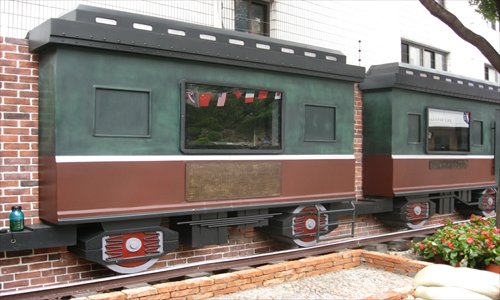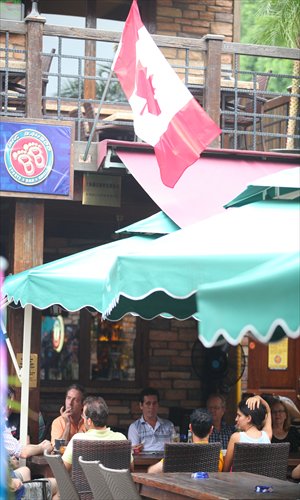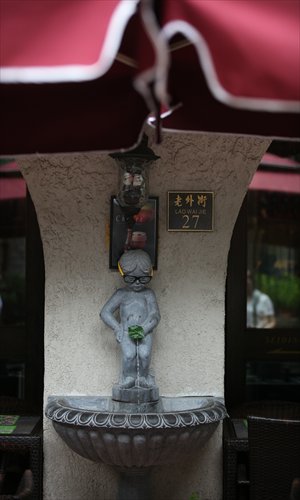Where laowai linger
As an expat-friendly city, Shanghai has unsurprisingly developed a number of destinations targeted at overseas residents and visitors. And one of the more popular is the somewhat awkwardly named "Laowai Street 101," whose official address is Lane 3338, Hongmei Road in the Hongqiao area of Minhang district.
The street has been popular for about 10 years with its interesting array of restaurants and bars. Recently this pedestrianized thoroughfare was honored as a National 3A-level Scenic Spot.

The "101" in the street name can be traced back to an alleged event involving China's former leader, chairman Mao Zedong, back in September 1971. Part of Hongmei Road formerly included a railway line and legend has it that Mao's special train, numbered 101, stopped close by as part of his plans to evade an assassination attempt by his deputy Lin Biao. A bronze plaque recounting this tale is attached to a wall in the street.
A walk down Laowai Street 101 offers visitors a view of diverse-styled buildings on one side of the street, and outdoor seating on the other. The 500-meter-or-so-long road has clusters of restaurants serving the cuisines of more than a dozen countries including India, Iran, Mexico and Italy. But the street also highlights a number of homegrown eateries offering Shanghai, Anhui and Xinjiang dishes, among others.

Mediterranean flavors
Having only opened for a trial period about a month ago, Olger Mediterranean Restaurant (No.38, 6465-9366) features three kinds of cuisines - Spanish, Italian and French.
Paella is one of the restaurant's highlights. This authentic Spanish staple is made from partly-cooked rice, shrimps, squid, mussels, smoked meats, and green beans among other ingredients. If local customers are not used to the "half-done" rice, they can ask for the rice to be fully cooked through.
The couple who own the eatery lived in a number of Mediterranean countries for a few years, which is how they picked up experience of running a similar business. "Most of our dishes conform to authentic Mediterranean dishes, but one of our pizzas has some typically Shanghai flavors added into it," Dina Zhao, manager of the restaurant, told the Global Times.
This Friday will see the official opening of this restaurant, and Zhao told the Global Times that all beers will be free that day. Before the official opening all dishes are being sold at a 30 percent discount.

Diverse options
If customers are looking for food-on-the-go, they can try a variety of Spanish snacks at Las Tapas (No.33, 6465-8345), which now has three branches around the city.
Meanwhile, down the road at No.28, Simply Thai (400-880-7729) is another popular destination around the city, despite its relatively expensive prices. However, the restaurant offers a 50 percent discount on certain dishes every Monday before 7 pm.
Green curry, grilled pork neck and Tom Yum Kung (hot and sour shrimp soup) are three of its specialties.
Shiraz (No.8, 6465-9993), an Iranian restaurant offering Middle Eastern cuisine, is a great place to have a smoke on a hookah pipe. A single pipe costs 85 yuan ($13), while the double variety will set you back 120 yuan.
Indian cuisine can be found at Delhi Darbar (No.5, 6465-8366), where the curried mutton comes highly recommended.
Bars are also a big attraction on the street. Perhaps the two most popular are Blue Frog (No.30, 5422-5119) and Big Bamboo (No.20, 6405-8720), which sell typical American food and beers. Big Bamboo offers a large number of outdoor tables and large screens where there will be live broadcasts of the 2012 Olympic Games which start on July 28. The bar's yard also features a children's slide. Blue Frog, meanwhile, is famous for its snacks including nachos, hamburgers and French fries.

A touch of traditional Chinese
But among all the commercial outlets, there are also some gems highlighting traditional Chinese culture and heritage to be found. Near Blue Frog stands an old factory building where the Shanghai Hanlin Biane Museum (Bldg 4, 731 Hongxu Road, 6406-5972) is located.
Above the front door there hangs a biane (a wooden plaque with Chinese calligraphy characters) which says Han Lin Yuan (or "imperial academy" in English). Walking into the museum gives visitors a feeling of traveling back in time to ancient China. The interior is decorated in the style of ancient China and includes a guest hall, study and teahouse. Most of the furniture - including wooden tables, chairs and folding screens - are original items privately collected by the museum curator Hong Tao.
However, the most valuable exhibits here are the historic biane hanging high above the house. Biane were commonly seen in China to show a building's name or purpose, to deliver words of blessing, or to proclaim a person's job title or status. At the current time, biane from zhuangyuan (the No.1 scholar in the imperial examinations) during the Qing Dynasty (1644-1911) are on display.
"Biane is one of the signature features of traditional Chinese culture. However, it is seldom studied or valued as much as other historic items," Hong told the Global Times. "In my collection there are four kinds of biane related to scholars, high-ranking officials, family ancestral halls and officers in the Republic of China (1912-1949)."
The museum has collected 1,673 examples of biane over 18 years from 22 provinces nationwide. Perhaps the most cherished are 10 biane representing emperors and prime ministers from feudal China.
Exhibits from the museum's biane collection can also be found at 122 Dongjing Street in Zhujiajiao town in Qingpu district.
The museum also functions as a teahouse for Xigua Dahongpao Tea (one of the most recognized dahongpao tea brands in China) which originates from Wuyi Mountain in Fujian Province. Visitors can enjoy tea-making ceremonies taking place.